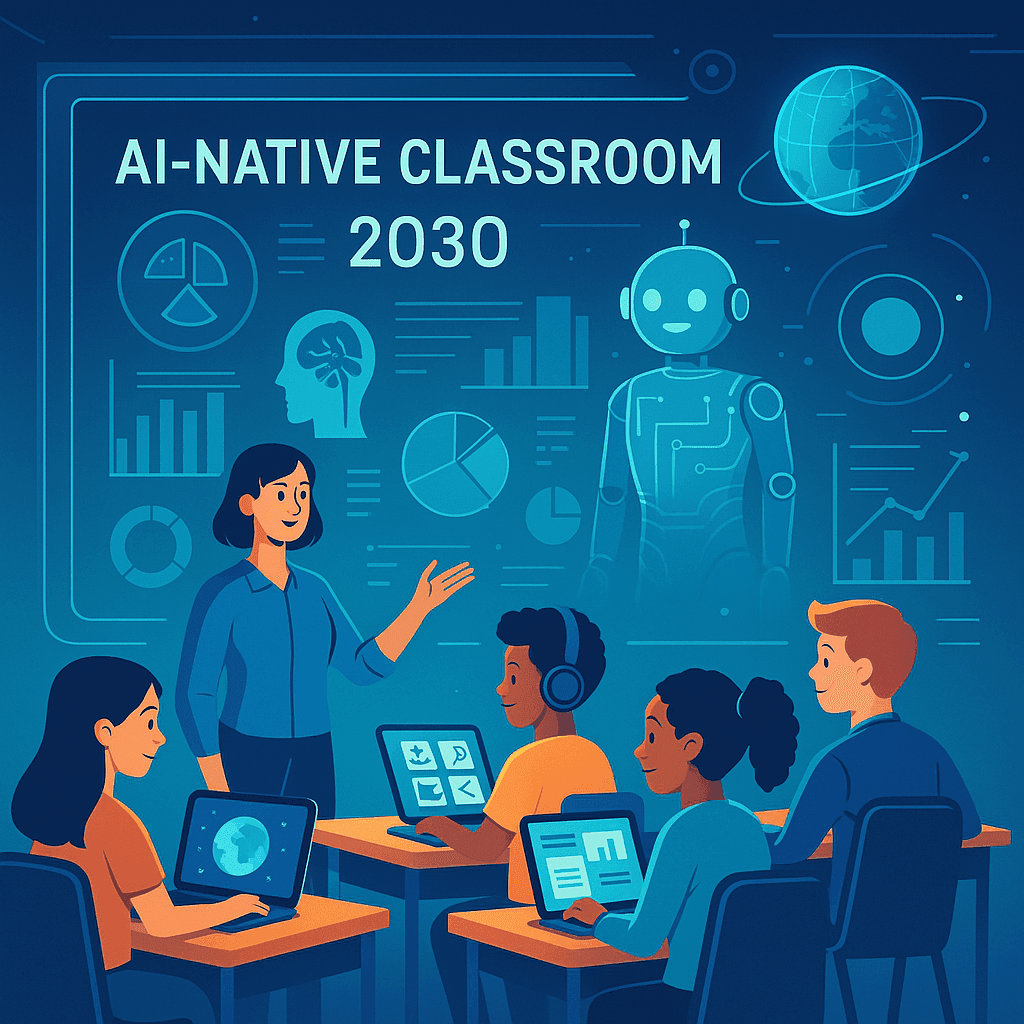
The question “What will the AI-native classroom look like by 2030?” sparks both curiosity and excitement. As artificial intelligence continues to evolve at an unprecedented pace, its integration into educational systems is becoming more sophisticated and transformative. By 2030, AI will likely be a fundamental aspect of everyday teaching, learning, and assessment.
The term “AI-native classroom” refers to learning environments where AI tools are fully integrated into curriculum delivery, assessment, collaboration, and administrative processes. From intelligent tutoring systems to predictive analytics and personalised learning paths, the classroom of the future will be a dynamic blend of human expertise and technological innovation.
AI and Special Education: Customizing Learning for Every Student
The Art of Crafting Compelling Case Studies: Tips for Success
What Will the AI-Native Classroom Look Like by 2030?
The AI-native classroom of 2030 will be characterised by several key features, all aimed at enhancing educational outcomes, increasing accessibility, and streamlining teaching processes.
1. Personalised Learning Powered by AI
One of the most significant transformations in the AI-native classroom by 2030 will be the seamless personalisation of learning. AI-driven platforms will tailor lessons to each student’s unique strengths, weaknesses, and interests.
Example:
An AI platform called Century Tech currently offers personalised learning experiences by continuously adapting content based on student performance. By 2030, such platforms will be far more advanced, capable of predicting student needs and providing customised resources in real time.
For instance, a student struggling with algebra may receive instant supplementary videos, practice problems, and AI-generated explanations tailored to their specific difficulties.
2. AI-Powered Assessment Systems
Assessment will be another area radically transformed by AI. By 2030, AI-native classrooms will rely heavily on automated assessment tools that can evaluate everything from written essays to complex project-based tasks.
Example:
Tools like Gradescope already use AI to assist with grading large volumes of assessments. By 2030, AI will not only grade objective questions but also provide detailed, formative feedback on open-ended tasks. This will allow teachers to focus more on higher-order teaching activities rather than administrative work.
Furthermore, predictive analytics will alert teachers to students who may be falling behind, enabling proactive interventions before performance gaps widen.
3. Enhanced Collaboration Through AI
The AI-native classroom by 2030 will also promote enhanced collaboration among students. AI tools will facilitate group projects by assigning roles based on individual strengths, suggesting relevant resources, and monitoring group dynamics to ensure equitable participation.
Example:
An AI tool designed for group work could suggest that a visually creative student handles the design aspect of a presentation, while a more analytical student focuses on research and data analysis. The AI would also provide real-time feedback on teamwork skills, such as communication and task delegation.
4. Virtual and Augmented Reality Integration
By 2030, AI-native classrooms will seamlessly integrate Virtual Reality (VR) and Augmented Reality (AR) technologies to provide immersive learning experiences.
Example:
Imagine a history lesson where students can “walk through” ancient Rome using VR headsets. AI guides their experience by highlighting key historical points, asking reflective questions, and adapting the content based on their interactions.
Similarly, AI-driven AR apps will allow students to visualise complex scientific concepts—such as molecular structures or planetary systems—directly on their tablets or smart devices.
5. AI-Enhanced Administrative Tasks
In the AI-native classroom of 2030, administrative processes will be largely automated, making teaching more efficient. Tasks like attendance tracking, scheduling, and report generation will be streamlined through AI systems.
Example:
Schools will use AI to automatically generate progress reports that highlight student growth, areas for improvement, and tailored recommendations. Teachers will spend less time on paperwork and more time engaging with their students.
Ethical Considerations and Challenges
While the vision of an AI-native classroom by 2030 is exciting, it is essential to address ethical considerations:
- Data Privacy: Ensuring that student data remains secure and private is critical.
- Bias in AI Algorithms: AI tools must be carefully monitored to prevent biased outcomes that could disadvantage certain student groups.
- Equity of Access: Schools must ensure that AI technologies are accessible to all students, regardless of socioeconomic background.
Despite these challenges, the benefits of AI-native classrooms far outweigh the drawbacks if implemented thoughtfully and ethically.
Conclusion
So, what will the AI-native classroom look like by 2030? It will be a dynamic, flexible, and data-driven environment where AI supports both educators and students in achieving their full potential. From personalised learning pathways to AI-driven collaboration tools, the classroom of the future will prioritise inclusivity, efficiency, and creativity.
Educational institutions that prepare for these changes today will be the ones that thrive tomorrow. By embracing AI as a tool rather than a threat, schools can enhance learning experiences, support diverse student needs, and promote a future-ready educational system.
Visit The Case HQ for 95+ courses
Read More:
A Step-by-Step Guide to Writing Impactful Business Case Studies
The Role of Case Studies in Academic Research: Best Practices
Case Study Writing: Turning Real-World Scenarios into Educational Tools
Critical Analysis: How Students Use Gen AI for Essay Writing—Should We Be Concerned?
Essential Comparison of CLSSGB vs CSSGB: Which Six Sigma Green Belt Is Right for You?
Powerful Guide to Writing Exam Questions Using Gen AI Effectively
Time-Saving Power of Using ChatGPT to Generate Lesson Plans in Minutes
Essential Guide: What Is Generative AI and Why Should Educators Care?
Innovative Ways Art & Design Schools Use AI for Portfolio Assessments
Transformative Power of AI for Assessment Dashboards and Performance Reports
https://thecasehq.com/exciting-vision-what-will-the-ai-native-classroom-look-like-by-2030/?fsp_sid=1084
Comments
Post a Comment